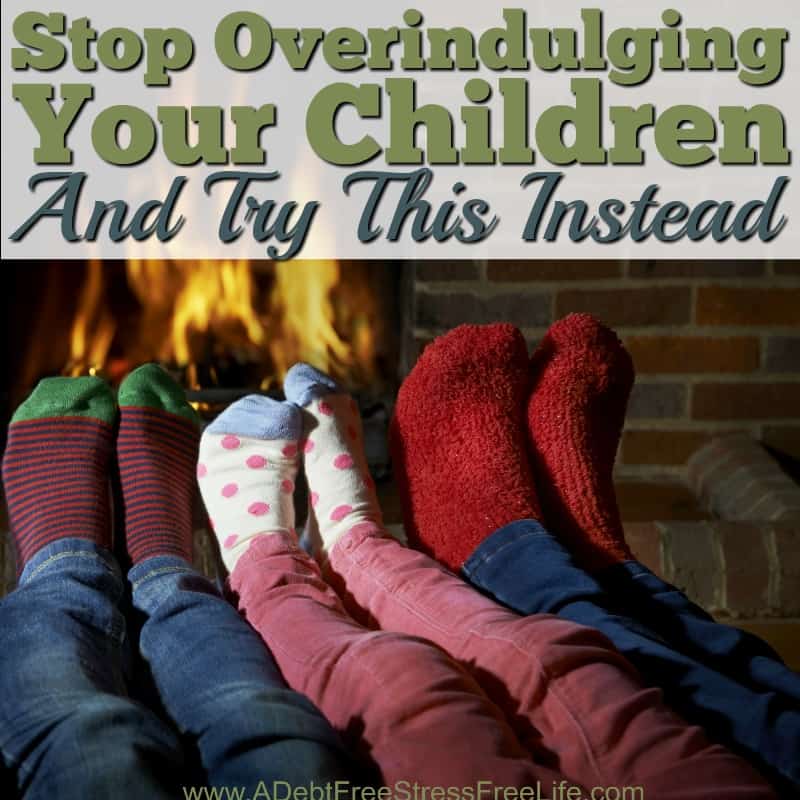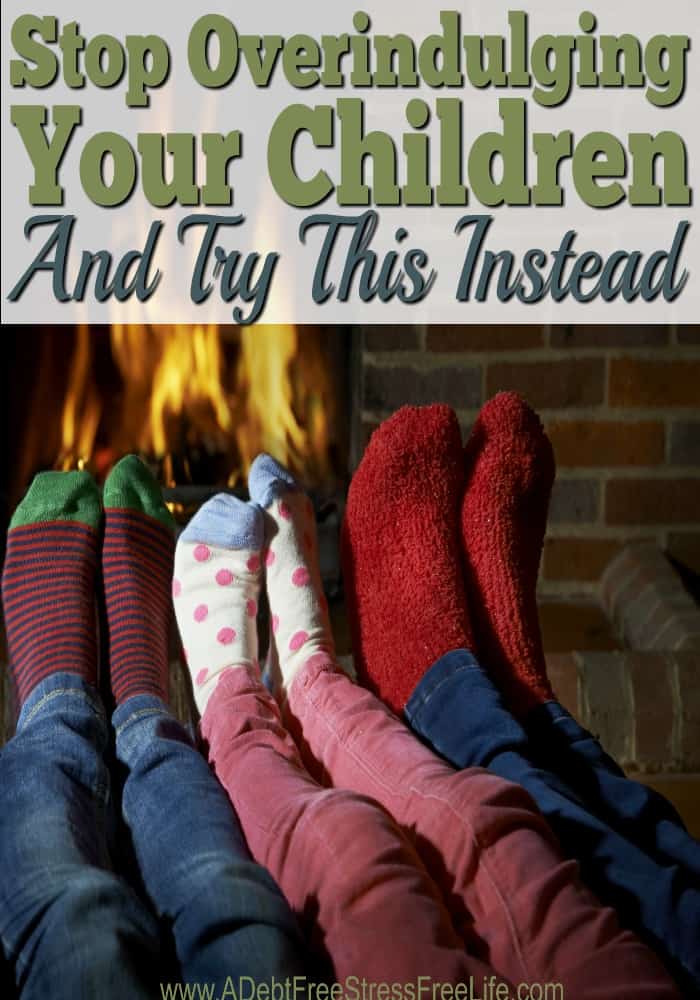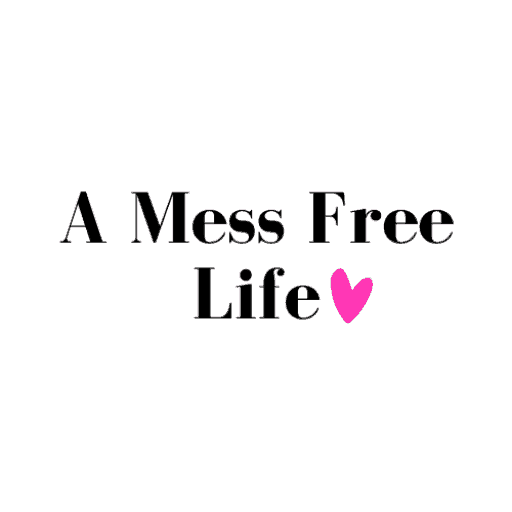A Mess Free Life may collect a share of sales or other compensation from the links on this page.
We’ve all seen it; the house that’s filled to the brim with children’s toys. They fill every corner of the room, turning a once pretty and organized home into complete chaos. It’s overindulging at it’s best.
I’ve read the countless blog posts on how to de-clutter your kids toy area, and how to do it in a way that makes everything all pretty and labeled, where everything has its place.
That sounds nice, but this isn’t about making it look pretty.

Table of Contents
Why You Should Stop Overindulging Your Children
This is about why you overindulge your child. Why do you, as a parent feel the need to bestow upon your child more toys than they could play with on a given day?
To ensure complete disclosure I want to tell you, I used to be that parent. My daughter had so many toys growing up you could barely see the floor in her playroom.
How Does A Parent Lose Control and Begin Overindulging?

I remember when Cabbage Patch Kids came out. They were THE hot toy in 1983. I stood in line with every other crazed parent to get my hands on a Cabbage Patch doll that resembled my brown-eyed beauty.
There were hoards of parents stalking the door to the warehouse, waiting for them to be brought out to the floor. That pallet never made it past the swinging doors. Parents were scrambling, pushing and shoving to get their hands on a doll. People were throwing them about, looking for one that resembled their child.
I’m ashamed to say I was part of the pack of wolves that left the store clerk in the dust as we grabbed, swapped and triumphantly claimed our prize.
Today, I have no idea what ever happened to that doll. My daughter didn’t keep it, and I assume at some point we donated it or threw it away.
Read: How To Avoid January Stress and Regret {AKA Holiday Overspending}
What was I doing? Or the better questions was why was I overindulging?
Back then I wasn’t aware of what motivated my behavior. I thought I was just a great mom who wanted to fulfill their child’s desires.
Now, I know better.
I was fueled by guilt.
We are a society of parents filled with guilt.
The guilt you have because you have to go to work every day.
Guilt you’re leaving your child in daycare or with a babysitter.
Guilt you’re getting a divorce and breaking up the family.
Guilt you’re not spending enough time with your child.
Guilt you can’t be a school chaperone because you have to work.
Guilt you tossed their artwork.
Guilt you don’t make cookies every day after school.
Guilt, your child, is a latchkey kid.
The guilt list is endless because it’s born of our insecurities, our lack of confidence, and our needs instead of the needs of our child. Guilt motivates us to do things, which if we stopped and reflected on what was going on at the moment, we would make a different choice. Instead, we allow our guilt to spawn our shopping frenzy’s so we don’t feel so bad, and our kids don’t feel so deprived.
But your child does not need an endless amount of toys. Your child needs you.
A thoughtful selection of toys aimed at educating and stimulating your child’s imagination is a good use of your resources. Purchasing everything your child asks for, that hits the stores or is the next hot item isn’t.
Joshua Becker wrote a great article Why Fewer Toys Will Benefit Your Kids and eloquently explains the rationale for fewer toys.
Read: Wants vs. Needs {And How To Tell The Difference}
The Problem With Giving, Giving, Giving (Overindulging)
If we give in to every demand our children make of us, how do they every understand as Mick Jagger said, “You can’t always get what you want?”
They grow up to be selfish, demanding, narcissistic people.
Our culture is full of people like this. You need to look no further than television shows like Keeping Up with the Kardashians to see this in action.
But most importantly we take away the opportunity to teach our children what joy and contentment feel like. Sadly, for the parent filling their children with an endless supply of toys and activities, it’s what’s missing in their life as well.
You see, your guilt is fueled by what’s missing in your life. You mistakenly believe overindulging them will somehow make you and them happy.
But you can’t shop your way to happy.
It can’t be done. I know, I tried.
Read: How To Stop Enabling The Shopaholic In Your Life
Present Spending Behavior Is Always Tied to the Past
My childhood was less than stellar. We grew up poor, never took vacations; I wore hand me downs, and had a less than attentive mother.
When I had my daughter, I was sure as hell not going to let her have the same experiences; so I overindulged.
Our society is filled with messages of overindulgence. You can barely escape it. The bigger, better, best syndrome is alive and well. It’s like a neon sign screaming ‘you too can be happy if you just buy this_______.”
It doesn’t matter what you fill in the blank with. A bigger house, nicer clothes, more shoes, better golf clubs than your friends. Any of it, or better yet, all of it, will make you happy.
It took me many years to change how I see overindulgence, where it comes from and how to push past those empty feelings and find healthier ways to fill the void than shopping. It wasn’t always easy. In fact, it was a hard, sometimes painful process.
Helping to correct my daughter’s ideas of joys and contentment after years of overindulgence wasn’t easy either. I was lucky that she hadn’t totally crossed to the other side. I was able to do a significant course correction during her teen years and have since helped her to look at her issues with buying too much stuff.
[tweetthis]True joy and contentment can’t be bought.[/tweetthis]
So, for all you parents out there – stop overindulging and purge the toy box.
Read: 25 Joyful Things To Do Instead of Shop on Thanksgiving
Here is a list of things to consider:
1. Make A Careful Assessment of Your Child’s Toys
Take stock of your child’s toy collection by bringing all the toys to one central location. Depending on their age, get them involved in this process.
2. Only Keep Toys or Games That Meet This Criteria
- Your child plays with regularly
- Are in good condition
- Have some special meaning attached to them
- Encourage creativity and use of their imagination
3. Get Rid of Toys and Games That Meet This Criteria
- If it’s mindless (like video games)
- Are broken, damaged or have missing pieces
- Your child doesn’t play with it anymore
- Causes fights
- Drives you nuts
- Have too many pieces (especially a million tiny pieces)
- Was expensive so you feel obligated to keep it
- Was a gift so you feel obligated to keep it
I know I’ll probably get a lot of slack for the mindless video game suggestion, but no one will change my mind. If the electronic game is educational in nature, then structured limited use is fine. But allowing your child to spend hours of his or her day playing games is just wrong.
They are disconnected from human interaction, are often exposed to violence, vulgarity and the like at an inappropriate age, and it does nothing to promote creativity and the expansion of their imagination.
If throwing toys and video games away feel wasteful to you, donate them to a local shelter or church group. For expensive items, consider selling them on your local Facebook yard sale group, Craigslist, Close5 or other online selling app.
What’s Next?
Now that you have a small section of meaningful toys selected store them in a way that makes sense for you and your children. Don’t leave them all out for your kids to play with as they want, but instead, keep them out of reach, introducing toys on a weekly basis.
Help cultivate your child’s imagination, love of reading, nature and science with hands-on learning and exploring.
Teach your child what true happiness and joy are all about. If you don’t know how, spending time together with your kids and family will begin to lay the foundation for more joy and contentment to fill your home. Pretty soon, you’ll get it.
Spending time together is more precious and meaningful than anything you ever bought.
In the end, putting a stop to overindulgences will help you and your child focus on what matters most – how to embrace joy and happiness with the things that last forever.





